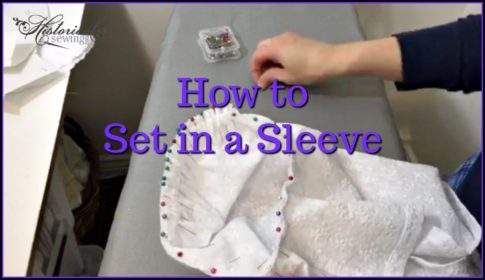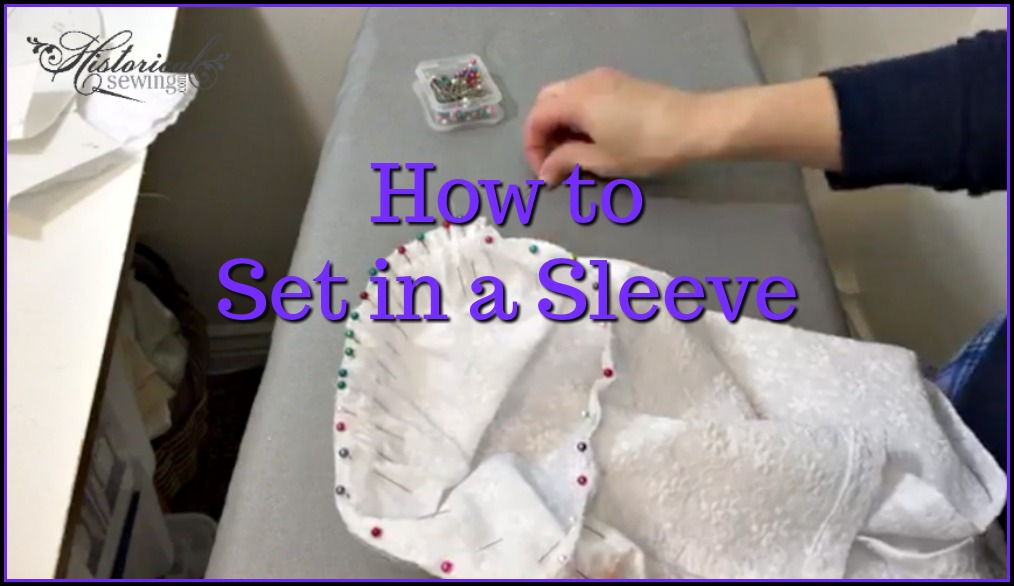
Sleeves seem to be that *thing * that bothers a lot of dressmakers, costumers and sew-ers. The term “sleev-evils” has been tossed around for a while now.
But I don’t want you to think of sleeves in that way. It only hinders you in getting that sleeve sewn and set into the bodice as quickly and easily as possible. You can do this!!
Before you get to the sewing stage of sleeves, make sure you have fit your pattern and reduced any fullness for a better look.
Is the underarm part high enough for movement? <– important if you want to move easily
Although, I mention this in the video below, you’ll find more tips in this post about not setting your sleeves in backwards.
Top Tips for Setting in a Sleeve:
- Select a sleeve then match up to the correct side of the bodice by checking notches and seams.
- Pin and sew around the inside of the sleeve with the bodice edge wrapped around it on the outside.
- Match and pin the straight areas first (generally around the bottom half) and finish with the eased or gathered top section.
- Sew with the sleeve closest to the presser foot so you can adjust pleats/gathers as you sew; this means the armhole circle “stands up” and moves through the machine in a vertical manner versus being wrapped around the free arm of your machine. ~It took me a long time to learn this as the best way to sew the sleeve.
- Press seam stitches flat first and finish raw edges; press seam towards sleeve at least around the top cap area.

Below is my Facebook Live video showing setting in a sleeve on my dirndl blouse from start to finish. Enjoy the tutorial!
Do you have any tips for sleeves you’ve found helpful over your sewing journey? Share them below.


On a related note, I am making a man’s dress tailcoat 1850’s and need some guidancse on the type of shoulder pads to use. The type is not specified and there are so many variation to choose from. Do you have a suggestion?
A “general” size like 1/4″ to 1/2″ thick will work. Check the fit of the coat on the wearer to see how thick you need/want them…. Put the coat on then add some layers of muslin on top of the shoulders under the coat and see how it looks; measure that little bit of added thickness for the size pads to get. The pads help keep the structure of the coat but aren’t like 1980s shoulders.
If you have a dress form, sew the sleeve together and do the gathering or ease stitches at the header. Then set and pin the sleeve onto the bodice armhole on the dress form. This will let you check that the sleeve is hanging properly in relation to the bodice, and you can see any potential fit problems before you sew it to the bodice.
Great idea!
Take a few minutes and baste the thing in by hand. The 3-5 minutes it takes means you don’t have the bumpiness of the pins to deal with (that pull the fabric out of shape). You’ll discover problems before you do it by machine, and hand basting is very easy to pull out quickly if necessary. Three minutes of basting can save an hour of profanities.
Sleeve question: how do you build a sleeve head if the pattern is sleeveless? Or if you want a different type of sleeve than the pattern offers? Obviously you do it on paper or scrap fabric first, but what are the steps?
This is intermediate to advanced pattern drafting. You can draft up a basic sleeve block then alter from there to your desired shape. My favorite flat patterning book is Pattern Making for Fashion Design by Helen Joseph Armstrong. Be sure to take seam measurements of both bodice and sleeve cap and adjust as necessary for the shape/gathering or pleating you want. And make a mockup! You could also try a sleeve from another pattern and work with that with your bodice.
A costumer friend committed the sin of not stopping when she knew she was too tired to muster through. A set of 40 police uniform jackets for a musical number, all the sleeves were pinned, tomorrow wpuld have been fine, but she decided to finish the job. Hours later she crawled into bed. After coffee, she went to her workroom and dis overed that every single sleeve was sewn on backwards. She called two friends and it took a short lifetime to undo and correct the problem.
DON’T push past reason.
Oh man!! ouch..
Thank you for sharing what you’ve learned, so we don’t have to learn the hard/slow way! The bit about how to feed the sleeve to the sewing machine is the part that has most discouraged me from making things with sleeves!
You are welcome. 🙂
Try this way next time and see how it goes. Of course, some tasks come easier to others, but don’t let that stop you from trying.